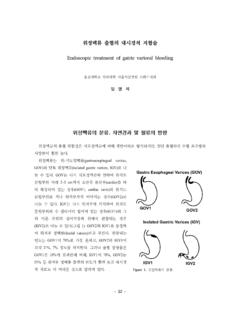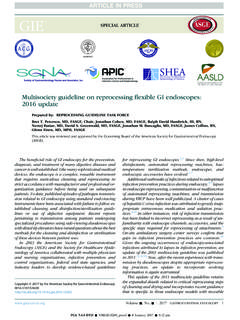Transcription of MST 3 - jges.net
1 MINIMAL STANDARD TERMINOLOGY FOR. GASTROINTESTINAL endoscopy . MST . Copyright 2008 OMED . All rights reserved. Organization Mondiale Endoscopia Digestive Permission is hereby granted without written agreement and without license or royalty fees to use copy or distribute the Minimal Standard Terminology MST for any purpose so long as this copyright notice appears on any copies of the MST. and that the following conditions are met. The notice of OMED copyright above should be displayed on every copy of the MST on all manuals and other materials used in connection with the MST including electronic media disks CD ROMs etc.
2 And should be apparent in text les loaded on these disks or onto the Internet. The content of the de ned core MST elds must not be changed. Users may add list items and sub-classi cation of items as needed as long as the diversion from the core MST structure is documented and traceable. OMED and the members of the OMED Committee for Standardization and Terminology do not accept liability for any omissions or errors in the MST and all EXPRESS AND IMPLIED WARRANTIES INCLUDING THOSE RELATING TO. MERCHANTABILITY OR FITNESS FOR A PARTICULAR PURPOSE ARE DISCLAIMED. 1 introduction 236. development 236. MST 3 MST 237.
3 MST modi cations to the MST 237. 2 anatomical structures 237. luminal anatomy 238. hepatobiliary anatomy 240. procedure/organ diagram 241. EUS anatomy 242. 3 endoscopic ndings and their attributes 245. luminal ndings 246. luminal ndings per organ 251. ERCP ERCP ndings 255. ERCP ERCP ndings per organ 258. EUS EUS ndings 260. EUS EUS lesion speci c attributes lists 269. EUS EUS ndings per organ 273. 4 reasons for endoscopy 274. upper endoscopy 275. colonoscopy 276. enteroscopy 277. ERCP 278. EUS 279. 5 endoscopic diagnosis 280.. upper endoscopy 280. colonoscopy 281. enteroscopy 282. ERCP 282. EUS 283. 6 procedures 284.
4 Luminal procedures 284. ERCP procedures . ERCP 287. EUS EUS procedures 289. 7 adverse events 290. intraprocedure events 290. postprocedure events 291. actions and outcomes 292. 8 appendices 292. classi cations 292. 1 introduction . development . Since computers became more readily available and relatively inexpensive, there has been increasing interest in their use for recording the ndings at endoscopy . The advantages are that it is possible to search any database created, perform statistical analysis, and avoid the need for hand- written or typed reports. Around the world, a considerable number of endoscopy record systems have been developed but there has been no standardization of the terminology used.
5 As a result, a golden opportunity has been lost for sharing and comparing data collected from different centers. Following a meeting on Computers in endoscopy organized by Pr. M. Classen in Munich in 1991, it became apparent that this important problem needed resolution. ESGE organized a committee under the chairmanship of Pr. M. Crespi and included a number of experts from Belgium, France, Germany, Hungary, Italy, Spain and the United Kingdom . Dr. Maratka from Czech Republic was invited to join the Committee because of his hallmark on endoscopic terminology for the Organisation Mondiale d'Endoscopie Digestive OMED.
6 At an early stage, it was felt important that the other World Zones be represented and representatives from the USA and Japan were added to the Committee. Additionally, the three major endoscope manufacturers Fujinon, Olympus and Pentax . and the publisher Normed-Verlag were invited to join the committee as it was imperative that industry should be involved in this work as they were developing their own systems and compatibility between these was regarded as vital if the opportunities for sharing data were to be optimized. It was also important that these companies be involved in discussing other aspects, such as image capture, storage and transfer.
7 Between 1992 and 1993, a series of meetings of this Committee were held, concluding with a joint meeting of the ESGE group and the Computer Committee of the American Society for Gastrointestinal endoscopy ASGE . At this time, the work was reviewed and modified and the Committee was constituted as the Working Party for this report for the World Congresses of Gastroenterology and Digestive endoscopy . The major aim of the project was to devise a minimal list of terms that could be included within any computer system used to record the results of a gastrointestinal endoscopic examination. The lists should not be exhaustive, and the work should not result in complete software.
8 Rather, the MST. should for the basis for various software vendors to facilitate common structure and language. In addition, the MST should provide assistance in the standardization of endoscopic image storage and transfer between individual systems and in the structure of reports. The list of terms proposed relied heavily upon the original and detailed work performed by the OMED committee under the chairmanship and guidance of Pr. Z. Maratka. His book provides the framework, as well as the de nitions for most of the MST terminology. This will provide a reference for users unfamiliar with the words employed.
9 MST formed the basis for prospective testing of the Terminology in Europe and the United States. This testing was funded by the European Commission through the Gaster Project and the American Digestive Health Foundation . This work resulted in a number of modifications implemented in the MST in 2000. Since then, this version of the MST has been implemented in a number of software solutions, mostly with various modi cations. MST 3 MST . The MST copyright and responsibility was transferred to the OMED society for further development. The committee of terminology and standardization has been in charge of this task, which has resulted in the present MST version.
10 While the original ideas of Prof. Maratka, ESGE, ASGE and the Gaster project have been retained, some modi cations have still been put in place in this revision. EUS and enteroscopy including capsule endoscopy have been included The lists of ndings have been reorganized, with one generic list for each main category luminal, ERCP, EUS . This is coupled with a table to indicate which findings are relevant for which organ. The ERCP terminology has been revised to allow more precise description of maneuvers, as well as ndings The lists for indications and diagnoses have been extended and somewhat revised.





